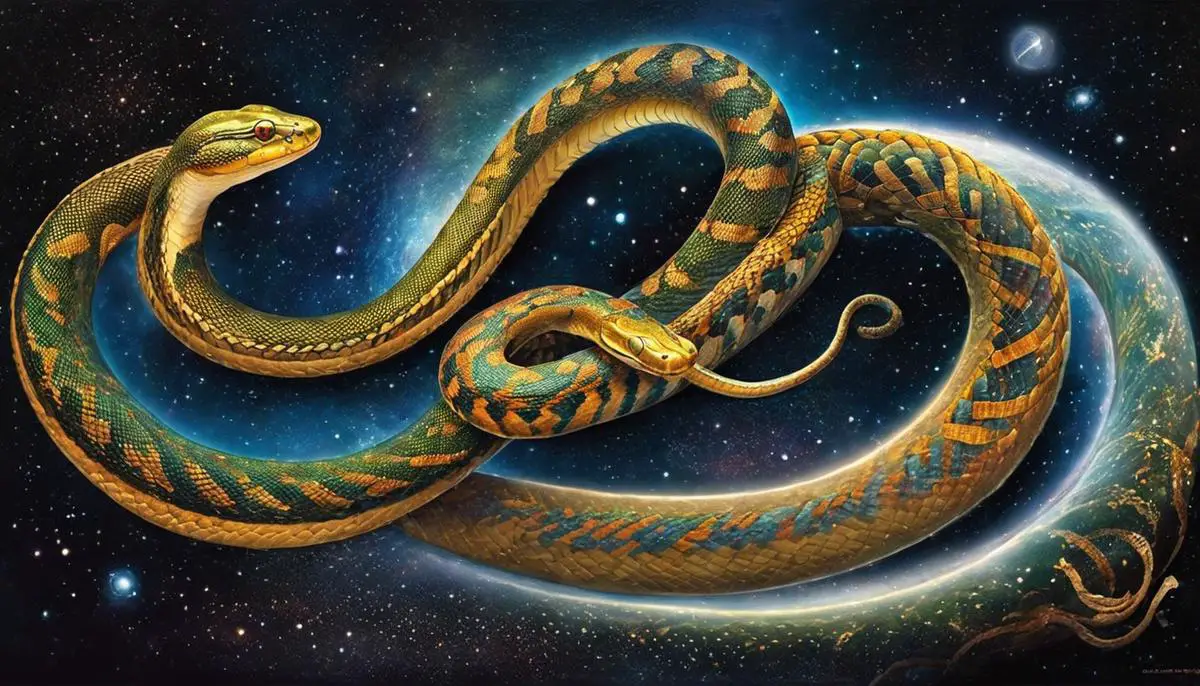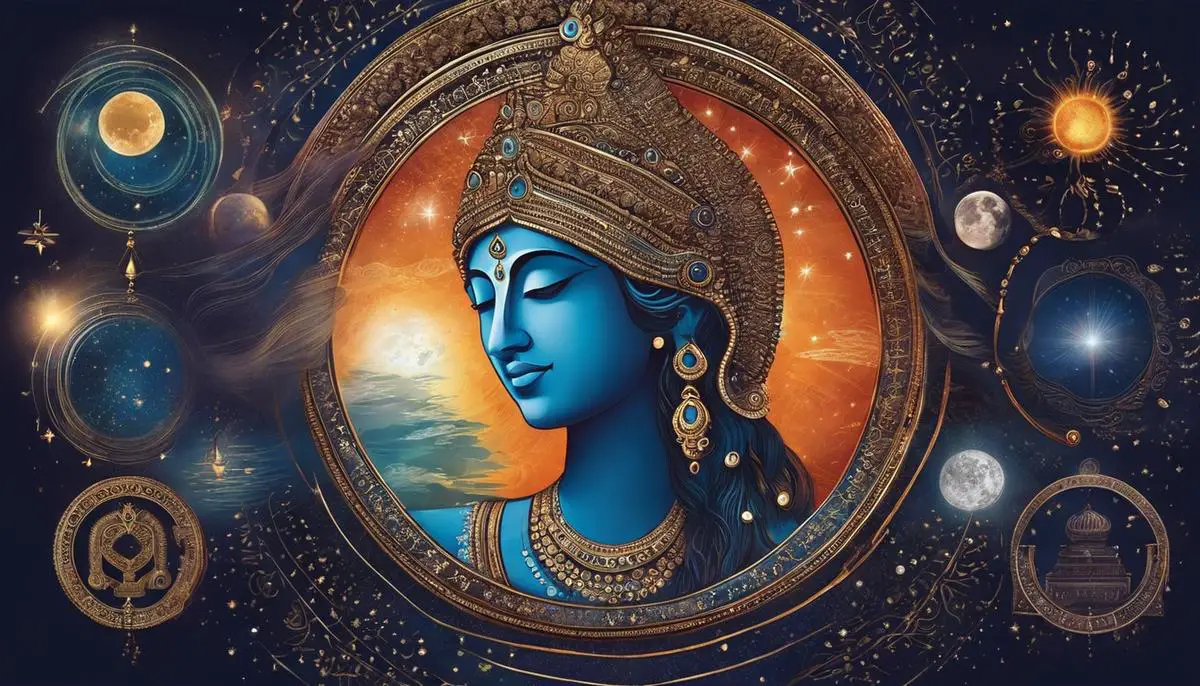In the realm of mysticism and spiritual symbolism, the interpretation of dreams takes on incomparable prominence, especially in the rich tapestry of Hindu Astrology. This astrological system, with its roots stretching as far back as 2nd millennium BCE, offers insightful perspectives to dream analysis, establishing unique correlations between the subconscious imagery and cosmic interpretations. Of the many motifs in dreams, the one that has intrigued mystics and common folk alike, is the enigmatic serpent. As a potent symbol, the snake, in the context of Hindu astrology, represents both spiritual transformation and ominous unknowns, making its analysis complex yet enlightening. With a focus on snake bite dreams, this exploration would provide a nuanced understanding of the different aspects related to symbolic interpretations and consciousness within Hindu astrological framework.
Hindu Astrology: An introduction
The Interpretation of Dreams and Snakebite Symbolism in Hindu Astrology: An Exegesis
At the heart of Hindu astrology, lies the profound exercise of dream interpretation, a tradition consummated over thousands of years of tapestry-weaving cosmic narratives. This age-old scholarly practice, mentioned in myriad ancient texts, explores the vast maze of the subconscious mind, enabling a nuanced understanding of future predictions. In particular, one recurring motif that has captivated students and scholars of astrology alike is the archetypal dream of a snake bite.
The archaic Hindu practice delineates the cosmos into nine celestial bodies, or ‘Navagraha’, each with a distinctive influence on human life. Dreams, in this context, are considered reverberations of these cosmic influences, communicating through enigmatic symbols and scenarios. An elucidation of these dream symbols, therefore, pivots on the knowledge of this celestial map.
Snake bite dreams, considered pivotal, draw from the rich mythological repository associated with serpents (Sarpa in Sanskrit), creatures considered emblematic of cunning, fertility, and transformation. Intersecting this with astrology, brings forth the concept of ‘Sarpa Dosha’ (Snake curse), a grave planetary insufficiency associated with the celestial bodies Rahu and Ketu, the serpent deities.
The symbolism of snake bites in dreams often communicates the need for spiritual awakening or transformation. They represent multifaceted aspects – toxicity, fear, unconscious elements, or even healing, depending upon the specific contextual details of the dreams.
A snake bite dream can be a signal of ‘Kala Sarpa Dosha’, indicating hardships encoded in one’s natal chart due to Rahu and Ketu’s positions. Often, it implies an upcoming phase of trials and tribulations that require resilience and perseverance.
However, it is imperative not to espouse a one-size-fits-all decoding of snake dreams, for context molds interpretation. For instance, a snake bite on the left hand could suggest deception, while a bite on the right hand might hint at a forthcoming health affliction.
But then again, dreams about snakes are not all gloom and doom. As per ‘Jyotish Shastra’ (Hindu Astrology), if one encounters a snake shedding its skin in a dream, it signifies a rejuvenation phase, symbolizing that the dreamer is discarding the outmoded for the new, undergoing a process of renewal or rebirth.
To unravel the complex weave of dreams and their cosmic ties therefore requires adept scholarly knowledge. While modern Western astrology values the psychological dimensions, Hindu Astrology emphasizes understanding the cosmic map and mythological connotations, thereby presenting a fascinating symbiosis of the esoteric and the empirical. In this nuanced dance between stars, planets, snakes, and dreams, exists a sophisticated knowledge system, attesting to the profundity of ancient Hindu wisdom.

Symbolism of Snakes in Hindu Astrology
Delving deeper into the realm of Hindu astrology, it’s vital to recognize the multidimensional symbolism of snakes beyond the common dream interpretation. The perception of snakes in Hindu astrology is a fascinating exhibit of the intricate connotations drawn in this ancient, yet dynamically relevant system of knowledge. This comprehensive examination will further aid in discerning the metaphoric connotations associated with snakes.
In Hindu astrology, snakes are not merely creatures of fear or curiosity, they symbolize an amalgam of perspectives – complexity, wisdom, and karmic consequences. The Hindu mythological embodiment of the snake, in the form of the deity “Naga,” showcases the snake as a potent symbol of fertility, abundance, and environmental cycles.
In ‘Rahu Kaal,’ another tangent of Hindu astrology, the celestial serpent Rahu, one of the nine astrological planets, wields significant influence. Rahu, often portrayed as a serpent, symbolizes chaos, mystery, and upheaval. The transit of Rahu through the zodiac sign in one’s horoscope can impact the individual’s life in profound ways, determined by complex calculations and the positions of other planets and stars.
Moreover, the ‘Kaal Sarpa Dosha,’ a condition in one’s astrological chart where all the planets come between Rahu and Ketu, two mythological snake deities, often signifies major disruptions and turmoil. Astrologers, however, also suggest that this can be a pathway to intense spiritual growth and enlightenment. It reiterates the duality inherent in the snake symbolism – embodying both danger and wisdom.
Next, it is important to discuss ‘Sheshnag,’ the thousand-headed serpent that serves as a bed for the Hindu deity Vishnu. Sheshnag stands as an exemplar of servitude and karma (duty). Additionally, in this context, snakes are also seen as keepers of the vast cosmic knowledge, emphasizing the snake’s symbolism as a representative of wisdom and exploration of life’s deeper, metaphysical realms.
Lastly, snakes’ role in ‘Samudra Manthan’, the celestial churning of the ocean, characterizes the potential for transformation. The snake serves both as a churning rope and a container for deadly poison that emerges from the depth of the ocean – depicting the snake’s symbolic role as a harbinger of deep transformations which might initially be chaotic or even destructive, but ultimately lead to the creation and emergence of new realities and profound wisdom.
Characterized by such rich symbolism, snakes in Hindu astrology are preferred not as mere biological entities but as carriers of profound philosophical and metaphysical insights. It showcases the depth of Hindu astrology, where every symbol serves manifold theological, philosophical, and cosmic associations. This understanding provides a comprehensive view of the ancient knowledge system where snakes hold a unique position – as symbols of fear, joy, wisdom, chaos, and transformation in the celestial and the earthly realms.

Dream Analysis and Consciousness
Hindu epistemology extends beyond the realm of the physical, delving into the intelligible landscape of dreams. The Vedanta philosophy, one of the six orthodox schools in Hindu thought, underscores the intimate relationship between dreams and consciousness. It suggests a three-tiered framework of consciousness: Jagrat (wakeful state), Swapna (dream state), and Sushupti (deep sleep state), concluding with Turiya, the state beyond these three, symbolizing all-encompassing consciousness.
The dream state, Swapna, provides a conduit between the unconscious and conscious realities, defining a unique ontology. According to the Mandukya Upanishad, one of the ancient Hindu scriptures, during the Swapna state, the Atman, or the Self, withdraws from the external world and unfolds a world embedded within, illuminating the dream universe. Symbolic representation in dreams, including snake dreams previously discussed, is a manifestation of the subconscious engaging with a person’s latent samskaras (impressions gathered over lifetimes) and serving as a profound tool for self-discovery and introspection.
The seers of the Chandogya Upanishad identified dreaming as an information processing state. They suggested dreams, including snake dreams, are cognitive in nature and serve to process information suppressed in the Jagrat state, enabling an understanding of unconscious thoughts and energies. One could draw parallels here with modern psychoanalytic theories, although the depth of interpretation in the Hindu context tends to be far more spiritually oriented.
Moreover, Hindu thought grants dreams a predictive capacity, assigning them an integral role in determining future occurrences. The dream state and the physical state are considered interwoven, and events unfolding in dreams influence the state of reality. It’s noteworthy that such predictive value ascribed to dreams runs parallel to the symbolism ascribed to dreams in Hindu astrology.
Beyond understanding dreams on a personal level, their evaluation also occurs within the broader cosmic perspective of Hindu cosmology. For instance, the Puranic texts present the cosmic dream of Lord Vishnu, who dreams up the universe, linking dreams to the very creation and dissolution of the cosmos.
In conclusion, the Hindu perspective presents a complex and nuanced understanding of dreams and their relationship with consciousness. It integrates vast domains, ranging from psychoanalysis and ontology to cosmology and eschatology, offering deep insights into the potent realm of dreams. Not only do dreams play a sanctified role in hinting at future prospects, but they also provide an introspective tool for individuals in their spiritual journey toward higher truth and self-realization. This understanding offers a rich tapestry for readers and researchers desirous of exploring the mystical interconnection of dreams with the states of consciousness.

Snake Bite Dreams: Hindu Astrology Interpretation
Building on the rich groundwork of understanding Hindu astrology’s interpretations of dreams and the substantial relevance of snake symbolism therein, it is quintessential to delve deeper into the philosophical underpinnings that bolster such doctrines. A meticulous examination of the Vedanta philosophy illuminates its unabashed emphasis on exploring the concept of consciousness through dreams. This critical projection of Vedanta offers a succinct framework of consciousness that encompasses four states:
- Jagrat (wakefulness)
- Swapna (dreaming)
- Sushupti (deep sleep)
- Turiya (the fourth transcendental state)
Distinctively emphasized in this intellectual fabric is the Swapna state, which epitomizes the dream phase. Deftly treading the line between unconscious and conscious realities, the dream state in Hindu thought emerges as a fertile ground for psychological exploration. Its paramount significance is further endorsed as being an instrumental tool for self-discovery and introspection; the subjective tapestry of dreams furnishes a wealth of symbolic cues that provide valuable insights into the subjective workings of the human psyche.
Regarded per such premises, the Chandogya Upanishad—one of the oldest Upanishads—proffers a profound understanding of the cognitive nature of dreams. Deciphered as subjective projections of conscious experiences, these dream interpretations find intriguing parallels with modern psychoanalytic theories. The fluid expanse of dreams encompasses a repository of mental constructs that correspond to the world outside, hence reinforcing the psychoanalytic premise that dreams provide a decoding key to understanding the subconscious realm.
Furthermore, the prescient aspect of dreams, according to the sages of Hinduism, is a realm that invites extensive academic scrutiny. An intersection between the subjective terrain of human knowledge and the objective framework of reality, dreams in the Hindu tradition are not isolated nocturnal occurrences. They affect and reflect the very state of reality, hence using the ephemeral to comprehend the existential.
Positioning dreams in the grand cosmological canvas, Hindu cosmology presents an overarching perspective that relates dreams to the very mechanics of universal creation and dissolution. Perhaps the most striking illustration of this viewpoint is chronicled in the cosmic dream of Lord Vishnu—dreams here are not personal phenomena; instead, they are inextricably linked to the universal life-cycle embodying creation, preservation, and dissolution.
Finally, the profound insights on dreams in Hindu thought transcend the traditional boundaries of psychoanalysis, ontology, cosmology, or eschatology. Striking a harmonious chord between these discreet disciplines, it presents a more integrated, nuanced comprehension of dreams. The sanctity associated with dreams evolves from merely being omens directing future actions; they are gradually recognized as insightful tools contributing to the spiritual journey towards higher truth and self-realization. With profound and complex philosophies like these underpinning dream interpretation in Hindu astrology, even a seemingly simple image like a snakebite transcends the physical realm, carrying layers of symbolism, connection, and insight.

In the extensive annals of Hindu Astrology and dream analysis, the interpretation of the snake bite dreams remains shrouded in an enigma that demands deeper understanding. A potent symbol, the representation of the snake, and its bite within dream scenarios, propels individuals on a journey that ranges from spiritual awakening to wrestling with innermost fears, demonstrating transformative potential on multiple levels. Yet, the Hindu concept of Maya reminds us of the illusion that intertwines reality and dreams, encouraging an open aura of perception. Striding across the corridors of uncertainty, a conscientious exploration of snake bite dreams provides profound insights into the discourse of self-transformation and spiritual evolution, a unique synthesis of the corporeal world and the astral realm, subsequently leading us towards enlightened self-understanding.
